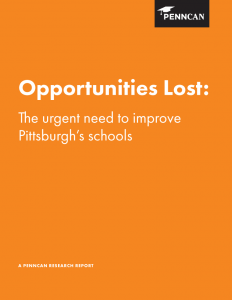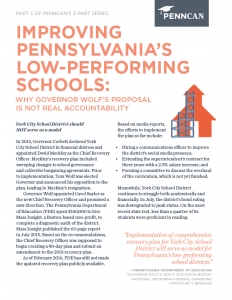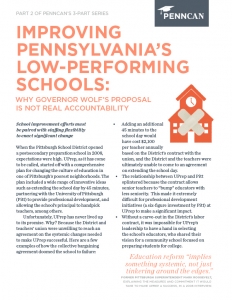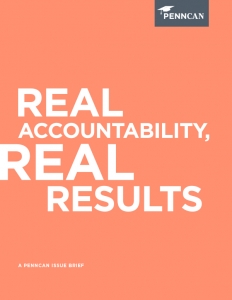
Intervening in underperforming schools is the hardest work in education policy. State and federal officials have been trying to turn around failing schools for years.
So what is it going to take to improve PA’s schools that are failing to educate children?
In our research, we have found that three core strategies must be on the table in any successful school turnaround initiative:
Planning
Research shows that school improvement plans (SIP) are often poor quality, not implemented with fidelity and are more likely to become compliance documents than catalysts for real change. The diagnostic audit done by Mass Insight at the York City School District was well done and provided research-based and practical recommendations for change. The problem was there was a lack of commitment to change the operations, staffing and learning structure at the district, so the plan was not put to good use and another year passed for the students in that district.
Staffing flexibility
School improvement efforts must be paired with staffing flexibility to enact significant change. As I said before, school turnarounds are difficult and they take a high level of commitment from administrators, teachers, community members and students. Research shows that one of the most prevalent reasons for the failure of a turnaround was the leadership’s inability to make changes due to labor contracts.
Charter conversions
Just as more money is not a silver bullet, charter schools are not the answer for every struggling school but a successful turnaround must include a conversation about a change in school management. There are a lot of unique and innovative aspects of charter schools that make them a great option for schools that have historically failed under district control. For instance, the ability to extend the school day or year, and instituting partnerships with outside organizations to provide specialized learning experiences for students.
Every Student Succeeds Act (ESSA)
ESSA provides Pennsylvania with a once-in-a-generation opportunity to pause and reflect on what has gone right (and wrong) since the implementation of the No Child Left Behind Act. It is an opportunity to make necessary changes to accelerate the pace of reform and build the public education system that we all want; a system that ensures all students have access to a 21st Century education that will prepare them for success in college and career.
Have You Heard?
What PennCAN is saying…
Blog: We are capable of great things when we join forces (6/13/17)
Op-Ed: Still flunking after all these years (6/11/17)
Press Release: For students trapped in low-performing Pittsburgh schools, every day is an Opportunities Lost (5/26/17)



